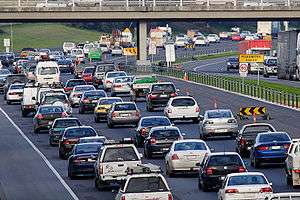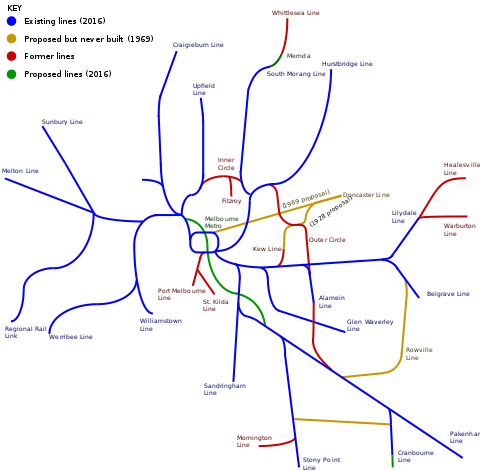1969 Melbourne Transportation Plan

The 1969 Melbourne Transportation Plan was a road and rail transport plan for Melbourne, the state capital of Victoria, Australia, instituted by Henry Bolte's state government. It outlined most prominently an extensive freeway network, much of which has since been built.
The plan recommended 510 kilometres (320 mi) of freeway for metropolitan Melbourne, as well as extensive railways, including the city underground loop and two new lines to Doncaster and Monash University (now Clayton Campus)[1] which were never built. Despite the majority of the printed material being devoted to non-car transport, 86 per cent of the projected budget was devoted to roads and parking, with only 14 per cent to other forms of transport.[2]
The plan was described J.M. Thompson in Great Cities and their Traffic as "clearly ... a highway plan, not – as it is called – a comprehensive transport plan" and by historian Graeme Davison as "the most expansive and expensive freeway experiment in Australian history".[3]
In 1973, some freeway plans were pruned especially in the inner city,[4] with State Premier Rupert Hamer cancelling all the road reservations for the unbuilt urban freeways in 1976.[1]
Some outer suburban projects continued to be built by subsequent governments under new banners, including EastLink (by the Steve Bracks government), the Peninsula Link (by the Denis Napthine government).
Background
The plan consisted of three volumes:
- Survey – completed for the Melbourne Transportation Committee by Wilbur Smith & Associates and Len T. Frazer & Associates
- Parking – completed for the Melbourne Transportation Committee by Wilbur Smith & Associates and Len T. Frazer & Associates
- The Transportation Plan – completed by the Melbourne Transportation Committee.
The scope of the plan specified surveys of vehicular and personal travel, transport facilities, goods movement by road and rail, and central city parking. It built on the previous major Melbourne Transport Plans:
- 1929 Plan of General Development, Melbourne by the Metropolitan Town Planning Commission, and
- 1954 Melbourne Metropolitan Planning Scheme by the Melbourne Metropolitan Board of Works
and the minor
- 1961 Metropolitan Street Service Study by Traffic Commission Victoria.
Goals
The goals of the plan were to:
- ensure safe, comfortable and efficient movement of people and goods throughout the design area
- maintain a proper balance between public and private transport
- make maximum use of the existing facilities and plans and the commitments already embodied in these plans
- provide a transport service matched to the expectant demand throughout the design area
- provide a system that could be adapted to meet changing conditions and be expanded beyond the design year
- provide a transport network which could be implemented with as little interference to the commercial and community structure as possible
Funding
The costs of the development of the plan were shared by the four participating authorities:
- Melbourne and Metropolitan Board of Works
- Victorian Railways Commissioners
- Melbourne and Metropolitan Tramways Board
- Country Roads Board
Minor contributions were provided by Melbourne City Council and the Transport Regulation Board.
Methodology
The process adopted was:
- Inventory of transport facilities, travel and developmental features of the study area
- Forecast of 1985 travel requirements (estimated population of 3.7 million)
- Evaluation of tentative 1985 plan
- Periodic review
Organisation
The organisation required to develop the plan included:
- Metropolitan Transportation Committee – a statutory body established in 1963 to advise government on all transport factors (and produce the third volume of the plan)
- Technical Committee – consisting of senior representatives of transportation and other authorities on the main committee, its job was to oversee all technical matters arising during surveys and preparation of the plan
- Consultants – Wilbur Smith and Associates (from New Haven, Connecticut) and Len T Frazer and Associates (Melbourne)
- Study Group – engineers who were assigned from participating authorities to be trained by the consultants and assist in data collection and analysis This group was expanded to include economists responsible for costing the final plan
Road
The plan proposed a budget of:
- $1.675 billion for freeways
- $64 million for divided arterial roads
- $28 million on new arterial roads
- $359 million on widening existing roads and bridges
- $95 million for road/rail 80 grade separations
Major radial
- F14 West Tullamarine Freeway - Built 1965-1979
- F4 West Calder Freeway - Built 1970-present
- F19 Eastern Freeway - Built 1977-1997
- F14 East Southeastern Freeway (Now known as the Monash Freeway), Built 1972-2003
- F9 West Lower Yarra Freeway (Now known as the West Gate Freeway), Built 1971-1978
Minor radial
- F9 East Healesville Freeway - Not built
- F4 East Freeway (Originally through the Pascoe Vale Road Alignment) - Abandoned
- F12 Freeway (Originally through the Ballarat Road Alignment) - Abandoned
- F1 Freeway (Originally to pass through the Inner City) - Abandoned
- F2 North Freeway (Originally to connect the Dingley Freeway to the Hume Freeway) - Abandoned
- F2 South Dingley Freeway - Partly built 1994-present, but not of freeway standard (Dandenong Bypass, South Road Extension and Westall Road Extension are part of the Dingley Arterial Project)
- F6 South Freeway (Now known as the Mornington Peninsula Freeway – Partly built 1975-present
- F35 South Frankston Freeway - Built 1962-1973
- F5 East Greensborough Freeway - Partly built, but not of freeway standard (Greensborough Highway)
- F5 West Freeway (Originally to pass through Essendon, Maribyrnong, East Sunshine and Footscray) - Abandoned
- F6 North Freeway (Originally to connect the Northern Ring Road to the Southeastern Freeway) - Abandoned
- F18 Freeway (Originally to connect the Northern Ring Road at Greensborough to the Eastern Freeway at Manningham) - Abandoned (See North East Link)
Inner city bypasses
- F6/F9 Southern Bypass (Now known as CityLink), Built in 1997
- F14 Western Bypass (Now known as CityLink), Built in 1997
Ring roads
- F3/F5 Western Ring Road - Built 1992-1997
- F5/F7 Northern Ring Road (Now known as the Metropolitan Ring Road), Partly Built in 1999
- F35 North Scoresby Freeway/Eastern Ring Road (Now known as Eastlink), Built in 2008
A North East Link between the eastern and northern ring roads was originally designed but has never been constructed.
Parking
The plan included a proposed budget of $40 million for improvements in parking in the Melbourne central business district.
Buses
The plan included a proposed budget $58 million for bus improvements:
- $50 million for 2,540 new buses
- $8 million for new bus depots
Rail

The forecasted budget for railway projects was $242 million. Planned rail projects included:[5]
- Melbourne Underground Rail Loop (estimated at $80 million and opened in stages from 1981)
- Three new railway alignments and one extension (budgeted for $60 million):
- Victoria Park - East Doncaster line (not built; now part of the PTV Network Development Plan)
- Huntingdale - Ferntree Gully extension - Rowville Line (not built; now part of the PTV Network Development Plan)
- Dandenong - Frankston extension (not built)
- Altona - Westona extension (now part of the Werribee extension and electrification from 1983)
- $8 million for extensions of suburban electric service along existing lines to Werribee (completed 1983), Rockbank (electrification to Melton to come), Sunbury (completed to Sydenham in 2002, electrification to Sunbury completed 2012), Craigieburn (completed in 2007), Coldstream (line now closed), Hastings (not considered) and Mornington (line now closed)
- $42 million for route capacity improvements on existing lines (upgrades to automatic signalling, duplication of 19 miles (31 km) of single track and 33 miles (53 km) of new express tracks in existing rights of ways)
- $2 million for new stations to be built on existing lines
- $35 million on additional suburban trains
- $15 million on modal interchanges (substantial increase in car and bus parking at suburban railway stations)
Trams
The plan included a proposed budget $55 million for 910 new trams.
See also
- Transport in Melbourne
- Ashworth Improvement Plan
- Operation Phoenix
- Lonie Report
- New Deal
- Regional Fast Rail project
- Victorian Transport Plan
Adelaide:
- Metropolitan Adelaide Transport Study - analogous 1968 transport plan.
Hobart:
- Hobart Area Transportation Study - Urban transport plan for Metropolitan Hobart area, published in 1965.
References
- 1 2 "Melbourne's Transport Task – an overview". www.melbourne.vic.gov.au. Archived from the original on 17 September 2006. Retrieved 2008-07-18.
- ↑ Public Transport Users Association. "Myth: They're not freeways, they're Integrated Transport Corridors". www.ptua.org.au. Retrieved 2008-07-18.
- ↑ Royce Millar (November 5, 2005). "On the road to ... where?". The Age. Archived from the original on August 23, 2006. Retrieved 2008-07-18. (via Google cache)
- ↑ "Issues and Trends: Transport" (PDF). Northern Central City Corridor Study. www.doi.vic.gov.au. Retrieved 2008-07-18.
- ↑ C L Fouvy. "The Melbourne region's opportunity and need for rapid transit" (PDF). Railway Technical Society of Australasia. Archived from the original (PDF) on 2008-07-21. Retrieved 2008-07-18.